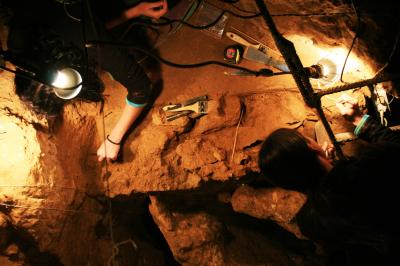August 2013. A new carbon-14 dating technique—the most advanced yet—has pinpointed the date at which Homo sapiens definitively replaced Homo neanderthalensis in Europe, a new report from Spain has concluded.

A research team coordinated by the University of Oviedo has been able to “accurately” determine the age of famous Neanderthal remains found in the El Sidrón cave (Asturias) for which “previous studies had provided inexact measurements,” a press release from the university said.
“The application of a pre-treatment to reduce contamination by modern carbon has managed to lower the margin of error from 40,000 to just 3,200 years,” the statement said.
El Sidrón cave in Asturias (northern Spain) is one of the westernmost Neanderthal sites on the Iberian Peninsula and contains a large amount of this type of remains in addition to the flint tools they used.
The age of the El Sidrón remains could prove to be an important piece of information in the discussion about when the transition from Neanderthal to Homo sapiens took place in Europe.
“Some previous datings that stated the remains were only 10,000 years old are inconsistent and cannot be considered credible. They would be highly disputed in the discussion about when Homo neanderthalensis became extinct,” as explained to SINC by Marco de la Rasilla, coordinator of the research team.
In order to adjust the age of these Neanderthals, De La Rasilla and his team compared previous results from the French Climate and Environmental Sciences Laboratory (LSCE, its acronym in French), with new data obtained by the Oxford Radiocarbon Accelerator Unit (ORAU).
The datings provided by both laboratories have enabled them to confirm that the Neanderthals from the Asturian cave lived some 49,000 years ago.
“The previous measurement of 10,000 years for this episode was due to a contamination issue,” De La Rasilla explained.
Carbon-14 is the most widely-used dating method in archaeology and it measures the age of the carbon found in an object. If the sample becomes contaminated with modern carbon or other substances then the object may appear younger than it actually is.
The new carbon-14 dating in Oxford’s ORAU laboratory was preceded by a highly sophisticated ultrafiltration treatment to reduce contamination as much as possible. The results revealed that the remains are between 45,200 and 51,600 years old.
The weighted average between this data and the data obtained previously by the French laboratory, where the sample underwent a different pre-treatment with ninhydrin to remove contaminants, places the Neanderthal inhabitants of El Sidrón 49,000 years ago.
“The fact that two separate laboratories using different treatments came up with similar figures makes this date even more reliable,” De La Rasilla concluded.
The problem with dating ancient bones many thousands of years old is an issue which has long plagued anthropologists. Fossils found in the Vindija Cave in Croatia have been dated to between 33,000 and 32,000 years old, and Neanderthal artefacts from Gorham’s Cave in Gibraltar are believed to be less than 30,000 years ago, but the new study appears to have thrown all those dates in to a quandary.
Homo neanderthalensis used to be included in the “human evolutionary ladder” as one step in the theory of evolution—called a theory because it is still essentially unproven—until the advent of DNA which showed that the species was in fact what is now called an “evolutionary dead-end” and did not survive the advent of Homo sapiens.
Even more recent DNA research has suggested that Homo sapiens outside of Africa have between one and four percent of Neanderthal genes, but even this has been disputed by other scientists.







